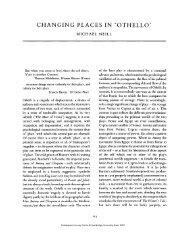the individualization of shakespeare's characters through imagery
the individualization of shakespeare's characters through imagery
the individualization of shakespeare's characters through imagery
Create successful ePaper yourself
Turn your PDF publications into a flip-book with our unique Google optimized e-Paper software.
INDIVIDUALIZATION OF SHAKESPEARE'S CHARACTERS<br />
compound mass, with tristful visage, as against <strong>the</strong> doom, is thought-sick at <strong>the</strong> act" (m, iv, 48).<br />
"While memory holds a seat in this distracted globe", says Hamlet, indicating his head (1, v, 96).<br />
The phrase "holds a seat" implies comparison <strong>of</strong> man's psychological function to a king's<br />
council in which each function, memory included, "holds a seat", i.e. is a member. Comparison<br />
<strong>of</strong> man to a state, so widespread in <strong>the</strong> Middle Ages, was very familiar to Shakespeare (cf.<br />
Coriolanus, 1, i, 101), just as was comparison <strong>of</strong> <strong>the</strong> state with <strong>the</strong> cosmos (Troilus and Cressida,<br />
1, iii, 85). All this use <strong>of</strong> allegory, typical <strong>of</strong> medieval thinking, is reflected in Shakespeare's<br />
language, and, consequently, in Hamlet's. The latter grieves over <strong>the</strong> death <strong>of</strong> <strong>the</strong> May-Day<br />
hobby-horse, over <strong>the</strong> disappearance <strong>of</strong> <strong>the</strong> old medieval revels. In <strong>the</strong> language <strong>of</strong> <strong>the</strong> common<br />
people, in Shakespeare's language, in Hamlet's language, <strong>the</strong>se 'hobby-horses' were still alive.<br />
If Hamlet speaks <strong>of</strong> <strong>the</strong>se things more <strong>of</strong>ten, perhaps, than do Shakespeare's o<strong>the</strong>r <strong>characters</strong>, <strong>the</strong><br />
reason lies in Hamlet's closeness to <strong>the</strong> common people.<br />
Hamlet's letter to Ophelia—"To <strong>the</strong> celestial and my soul's idol, <strong>the</strong> most beautified Ophelia"<br />
(11, ii, 109)—which Polonius reads to <strong>the</strong> King and Queen, is astonishing for its artless simplicity,<br />
as is <strong>the</strong> image "stars are fire" occurring in Hamlet's halting love verses. Hamlet himself admits,<br />
in this same letter, that "I am ill at <strong>the</strong>se numbers; I have not art to reckon my groans". In <strong>the</strong><br />
milieu to which Hamlet belonged, <strong>the</strong> court, this was something <strong>of</strong> an exception, which likewise<br />
sets Hamlet negatively, so to say, apart from this miheu. It must be remembered that his was<br />
<strong>the</strong> period <strong>of</strong> <strong>the</strong> cult <strong>of</strong> <strong>the</strong> sonnet. Hamlet's letter to Horatio (iv, vi, 13) is striking for <strong>the</strong> same<br />
artless simplicity—in an age <strong>of</strong> <strong>the</strong> cult <strong>of</strong> epistolary style and high-flown prose.<br />
Hamlet's poetic fantasy may be illustrated by his comparison <strong>of</strong> a cloud to a camel, a weasel<br />
and a whale (ni, ii, 400), <strong>the</strong> artless simplicity <strong>of</strong> which brings to mind folk-tales for children. The<br />
following image likewise echoes folk-lore: "Be thou as chaste as ice, as pure as snow", Hamlet<br />
tells Ophelia (in, i, 142). This carries us away to <strong>the</strong> world <strong>of</strong> images connected with <strong>the</strong> English<br />
popular ballad. The metaphor "<strong>the</strong> rose <strong>of</strong> innocent love" is also <strong>of</strong> this type. It is characteristic<br />
that Hamlet combines this metaphor with one purely realistic: he tells Gertrude that her act<br />
"takes <strong>of</strong>f <strong>the</strong> rose from <strong>the</strong> fair forehead <strong>of</strong> an innocent love, and sets a blister <strong>the</strong>re" (HI, iv, 42),<br />
hinting at a prostitute branded on <strong>the</strong> forehead. The following image also echoes <strong>the</strong> ballad:<br />
before his duel with Laertes Hamlet asks him to believe that "I have shot mine arrow o'er <strong>the</strong><br />
house, and hurt my bro<strong>the</strong>r" (v, ii, 257), i.e. accidentally committed a grave crime—a plot which<br />
might have served as <strong>the</strong> material, and perhaps did serve as such before Shakespeare's time, for a<br />
popular ballad. The poetic vein in Hamlet's <strong>imagery</strong> is close to <strong>the</strong> popular ballad.<br />
At first glance some <strong>of</strong> Hamlet's images seem stilted, but in reality <strong>the</strong>y are so common that<br />
<strong>the</strong>y may safely be classed as 'fossilized' images, in o<strong>the</strong>r words, as stock sayings. "In <strong>the</strong> very<br />
torrent, tempest, and, as I may say, <strong>the</strong> whirlwind <strong>of</strong> passion, you must acquire and beget a<br />
temperance", Hamlet tells <strong>the</strong> actors (in, ii, 6). This "as I may say" is very characteristic here.<br />
"Wings as swift as meditation or <strong>the</strong> thoughts <strong>of</strong> love" (1, v, 29) also belongs to this class.<br />
Possible exceptions are "<strong>the</strong> slings and arrows <strong>of</strong> outrageous fortune" (in, i, 58) and "to take<br />
arms against a sea <strong>of</strong> troubles" (in, i, 59) from <strong>the</strong> "To be, or not to be" monologue. Quite<br />
probably, however, <strong>the</strong>y too belong to <strong>the</strong> 'fossilized' images. In that case "slings and arrows"<br />
simply means 'blows', while "sea <strong>of</strong> troubles" is identical with "many troubles". This is all<br />
<strong>the</strong> more probable in <strong>the</strong> case <strong>of</strong> "sea <strong>of</strong> troubles", since only by regarding it as a 'fossilized'<br />
image can we eliminate <strong>the</strong> sharp violation <strong>of</strong> metaphoric unity which caused some commentators<br />
99 7-2<br />
Shakespeare Survey Online © Cambridge University Press, 2007



